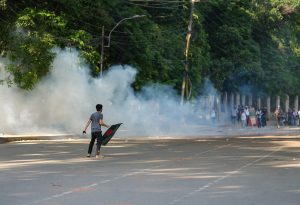Six months have passed since Bangladesh’s Prime Minister Sheikh Hasina won office for the fourth consecutive time through a controversial and non-competitive election. However, in contrast to the ease with which Hasina’s Awami League won re-election, her 2024-2029 term is not going smoothly thus far.
Currently, Bangladesh is witnessing a huge student-led protest over demands to abolish the quota system in government jobs. The protests started on July 1 and intensified on July 5, when the high court gave a verdict to keep the quota system in place. For over two weeks, students across all public universities have come into the streets to call for abolishing the quotas.
In a major escalation of violence on July 16, at least six people, including three students, were killed and several hundred injured in clashes between anti-quota protesters and pro-Awami League activists and police across the country
This huge protest’s roots trace back to April 2018, eight months before the national poll that year, when students took the streets over the quota issue. Back then, Prime Minister Hasina promised to abolish the system, saying, “There is nothing to get angry at; the students are demanding [an end to quotas], and I totally accept it.”
However, her tone has dramatically changed. This time, faced with anti-quota protests, Hasina dismissed students as “wasting their time unnecessarily in the name of the movement.” Speaking in a press meeting in Dhaka on July 7 she said, “After the court’s verdict, there is no justification for the anti-quota movement.”
On July 14, Hasina upped the ante when she commented, “Why do they [the protesters] have so much resentment towards the freedom fighters? If the grandchildren of the freedom fighters don’t get quota benefits, should the grandchildren of Razakars get the benefit?”
“Razakar,” referring to Bangladeshis who collaborated with Pakistan during the war of 1971, is a pejorative term in Bangladesh. This comment from the prime minister, made in a press conference after Hasina’s return from China, galvanized the whole country.
Around 10 p.m. that night, thousands of students from Dhaka University’s residential halls occupied the campus area and some major streets. Female students broke the gate’s lock at Royeka Hall and joined them on the streets. By 11 p.m., the city resonated with the students’ chanted slogans that ironically repurposed the term “Razakar” to denounce Hasina’s comment: “Who am I? Who are You? Razakar, Razakar. Who said that? Who said that? Autocrat. Autocrat.”
Students stayed on the streets for a few hours. In the meantime activists from the Bangladesh Chhatra League (BCL), the Awami League’s student wing, took up position on campus and attacked protesting students, reports say.
The next day, on July 15, students came into the streets across the country from different universities from around 12 p.m. BCL activists attacked the protesters in different areas, especially at Dhaka University. At least 100 students were hospitalized due to the violence on the campus.
In the evening BCL activists attacked the protesters at Dhaka Medical College Hospital.
At midnight Jahangirnagar University protesters also faced violence from BCL activists. Moreover, police fired tear-gas shells and rubber bullets.
Protesters claimed on social media like Facebook and X that the BCL members were hiring goons from the outside and attacking protesters with lethal weapons.
On July 16, the situation escalated dramatically. In addition to public university students, students from private universities such as North South University, BRAC University, University of Liberal Arts, and East West University, as well as higher secondary colleges like Notre Dame College and Dhaka Residential Model College, blockaded major points in the capital. Reports also emerged of attacks on protesters by BCL activists and police barricades.
At least six people were killed in the clashes, and dozens more injured. In the aftermath, the University Grants Commission asked all universities, whether public or private, to close. A dozen large universities have agreed to shut down, including Dhaka University.
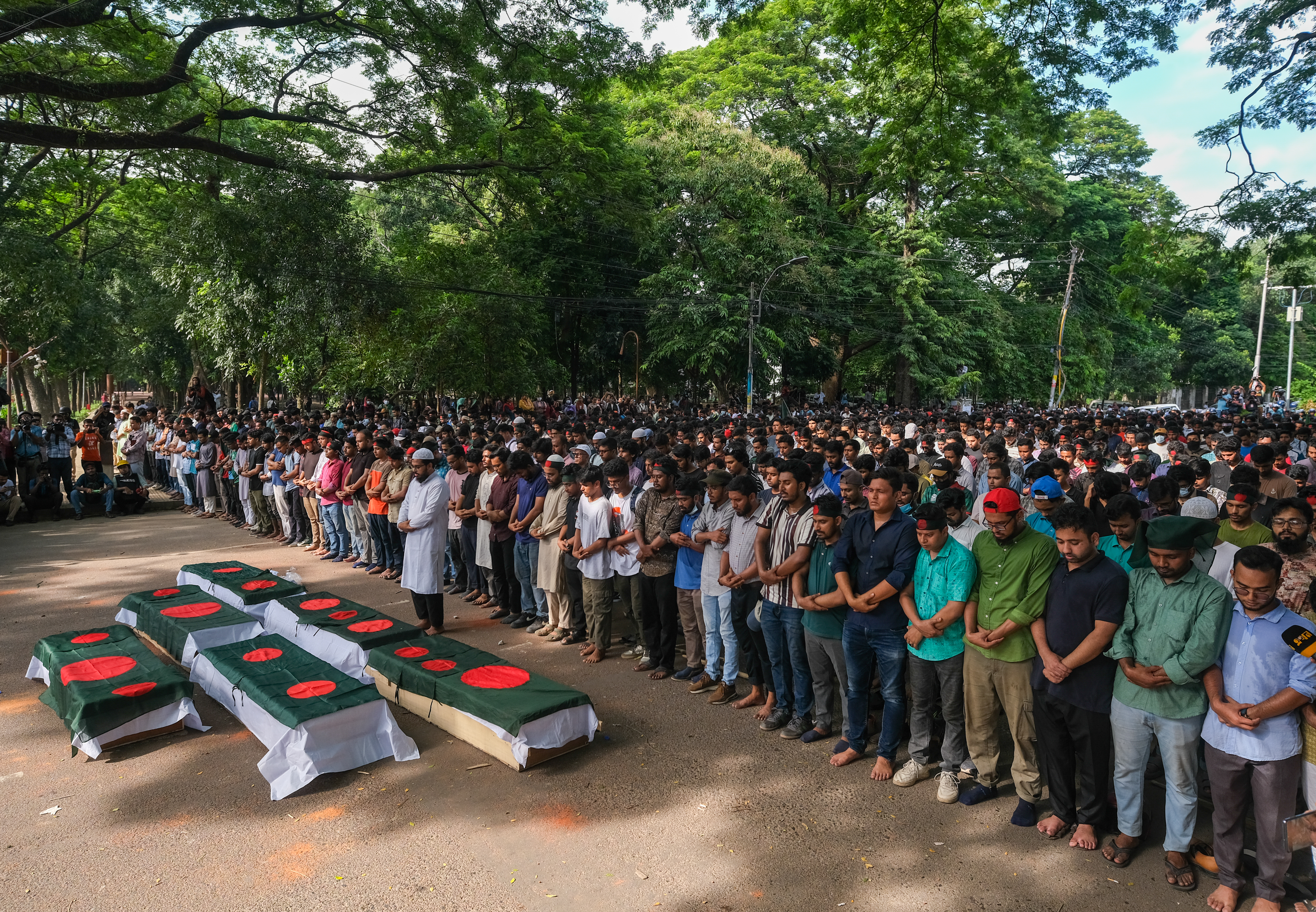
Students hold an absentee funeral prayer with symbolic coffins memorializing the six students who died on July 16, Dhaka, Bangladesh, July 17, 2024. Photo by Saqlain Rizve.
Meanwhile, on July 17 the students pledged a “complete shutdown” of the country in response to what they called unprovoked attacks by security forces on protesters. In preparation, 229 platoons of the Border Guard Bangladesh, a paramilitary force, were deployed across the country. 3G and 4G networks were shut off around 11 a.m. on July 18.
At the same time, police attacked students at BRAC University, shooting tear gas and sound grenades directly at the university campus. Other private university students also took to the streets. Around 1 p.m, on Thursday, police fired bullets in some areas.
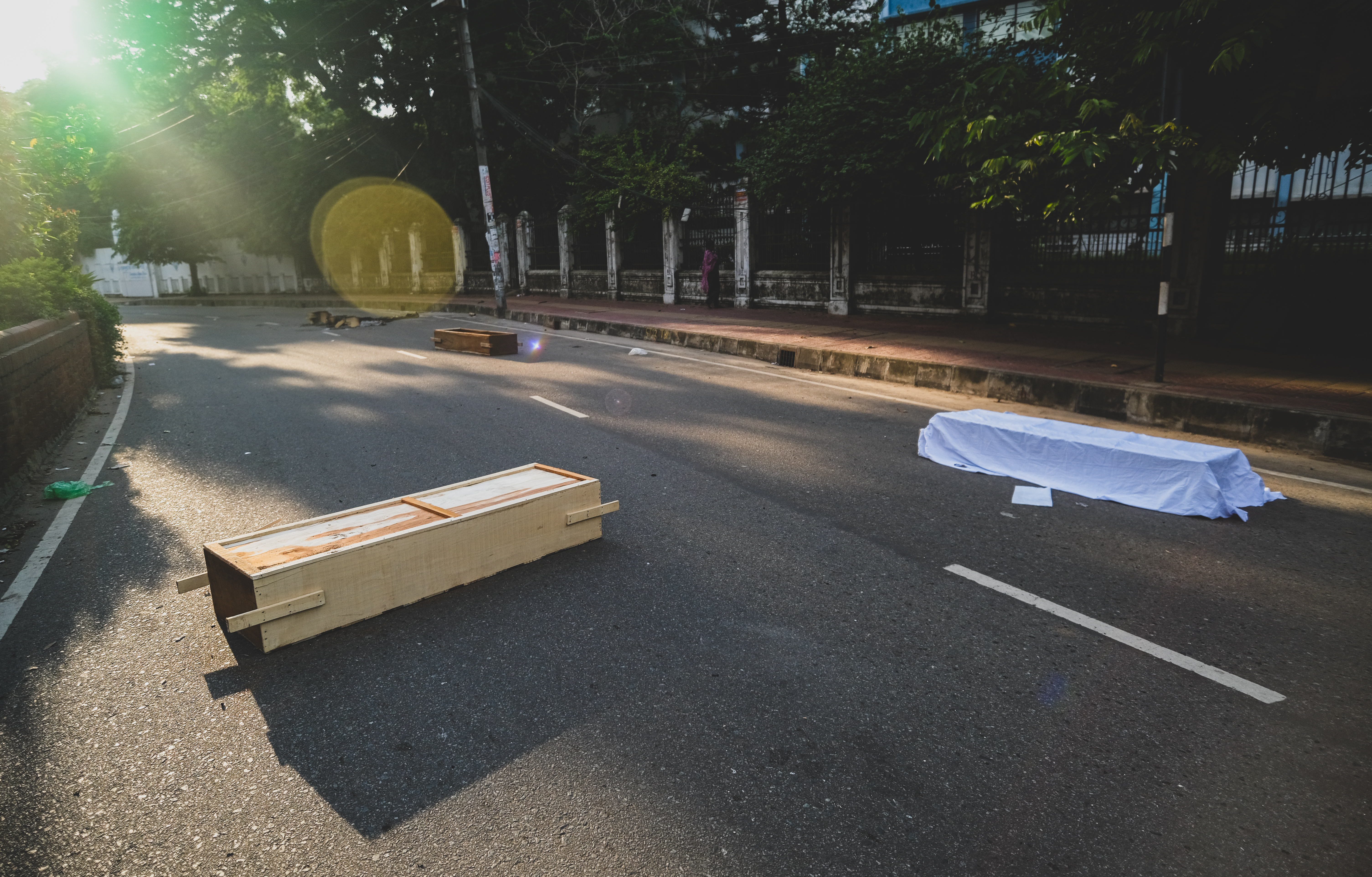
After the absentee funeral prayer, the students marched towards TSC, Dhaka University from VC Chattar with symbolic coffins. Law enforcement then fired tear gas and sound grenades, and students were forced to leave the symbolic coffins abandoned on a main road of the university. Photo by Saqlain Rizve.
Besides Dhaka, students also blocked roads in other cities like Chittagong, Khulna, Barishal, and more. Even secondary and higher secondary students joined the protests, and the police fired tear gas at them.
Around 2 p.m., the police surrendered to the students at Barishal University and allowed them to continue their protest.
Around 3:30 p.m., the government announced they wanted to negotiate with the students. However, the students refused talks, demanding justice for the six students killed so far in the protests. The protesters are now demanding a change in the regime.
Update: Since this story was first published, the death toll on July 18 has been estimated to be at least 19, brining the total number of deaths to 25.
The major differences between the 2018 quota protest and 2024 edition signal the winds of change in Bangladesh.
In 2024, students are directly calling Hasina a dictator and social media is flooded with the anti-Awami League comments from all classes, from celebrities to average people. Through writing, caricatures, videos, photos, and more, Bangladeshis, especially students, are directly calling the prime minister an “autocrat.”
This is a development that wasn’t seen in the 2018 protest. At that time, the government acted with more restraint, perhaps with the upcoming election — only eight months away at the time of 2018 protests — in mind. This time around, the election is in the past.
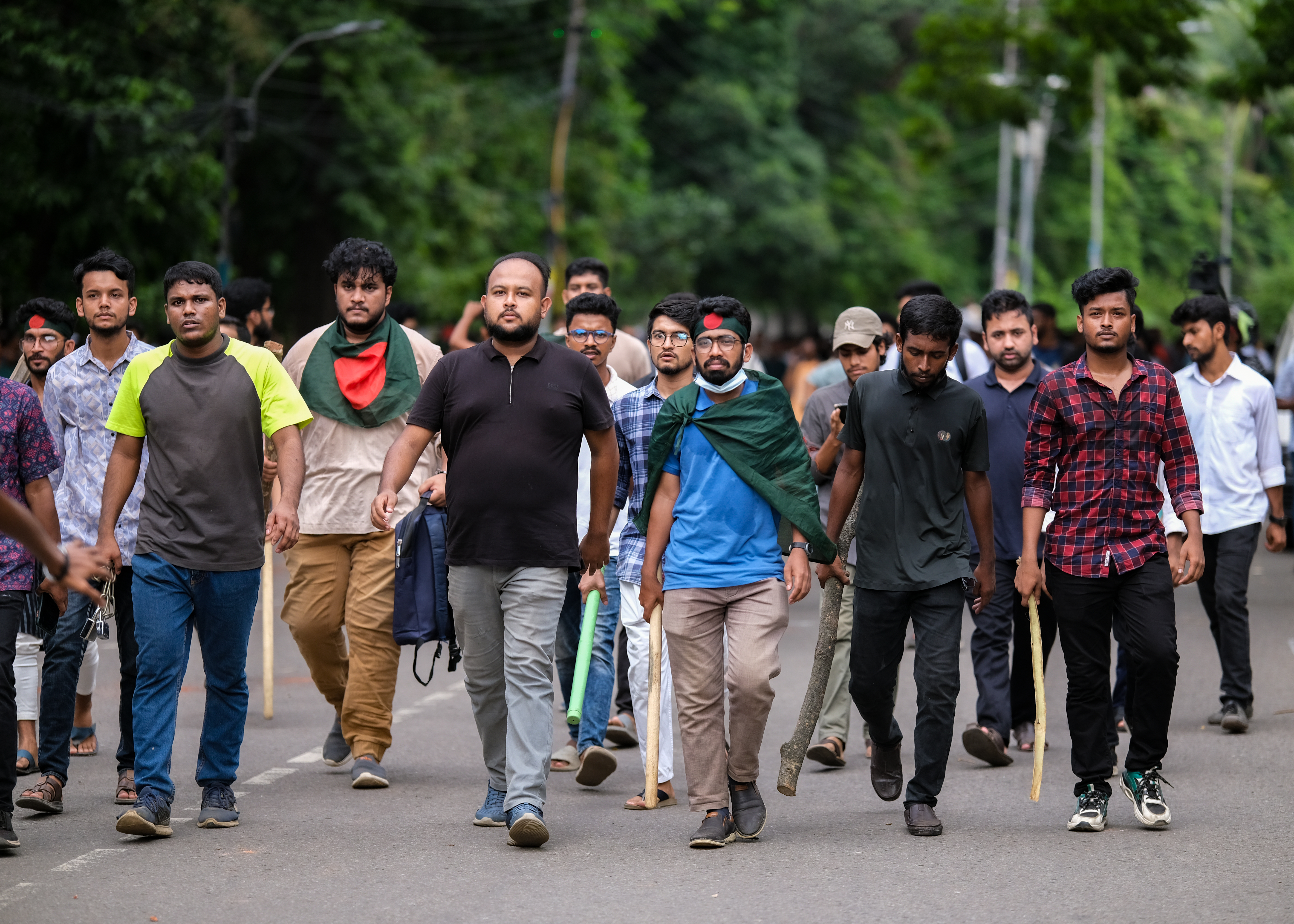
General students marching as they kicked off a day of protest from Dhaka University, July 17, 2024. Photo by Saqlain Rizve.
Another key difference is the general level of public discontent. In 2018, Bangladesh’s economy was experiencing robust growth, with a significant GDP expansion of 7.9 percent. Inflation was low, compared to current figures.
Fast forward to the present year, and Bangladesh faces significant economic hurdles. The compounded impact of the COVID-19 pandemic, the ongoing Russia-Ukraine conflict, and global economic challenges have put considerable strain on the country. Bangladesh’s foreign reserves, which stood at approximately $42 billion prior to 2019, have seen a decline, currently amounting to around $26.5 billion. The inflation rate was hovering around 9.7 percent as of June.
Moreover, so far in 2024, almost every month has seen corrupt government officials exposed in the media, with evidence of their million dollar assets. The exposés started with revelations of retired Inspector General of Police Benazir Ahmed’s black money and vast assets. Hasina herself affirmed during a press briefing a few days ago that one of her aides had illicitly amassed 4 billion Bangladeshi takas ($34 million) and was subsequently dismissed from the job.
Corruption is an old enemy for a developing country like Bangladesh. However, in the context of the current global economic downturn and rampant inflation, corruption stands out as a significant contributor to the economy’s precarious condition in Bangladesh. Essential commodities and foodstuffs now command prices that are a staggering one-third higher than before, burdening consumers.
Bangladesh’s economic challenges are compounded by increasing debt obligations. The government has incurred substantial debt to finance major infrastructure projects, with a significant portion funded by China through the Belt and Road Initiative. These initiatives aim to stimulate economic growth; however, they have also imposed a considerable repayment burden. As of 2024, Bangladesh’s debt-to-GDP ratio is projected to be around 36.4 percent. This financial pressure has implications for the national budget, potentially diverting resources away from measures that could mitigate the economic hardship faced by the populace.
Additionally, the unemployment rate among the youth is on an upward trajectory, exacerbating the situation. This has led to an accelerated “brain drain,” as more skilled individuals look to find employment abroad.
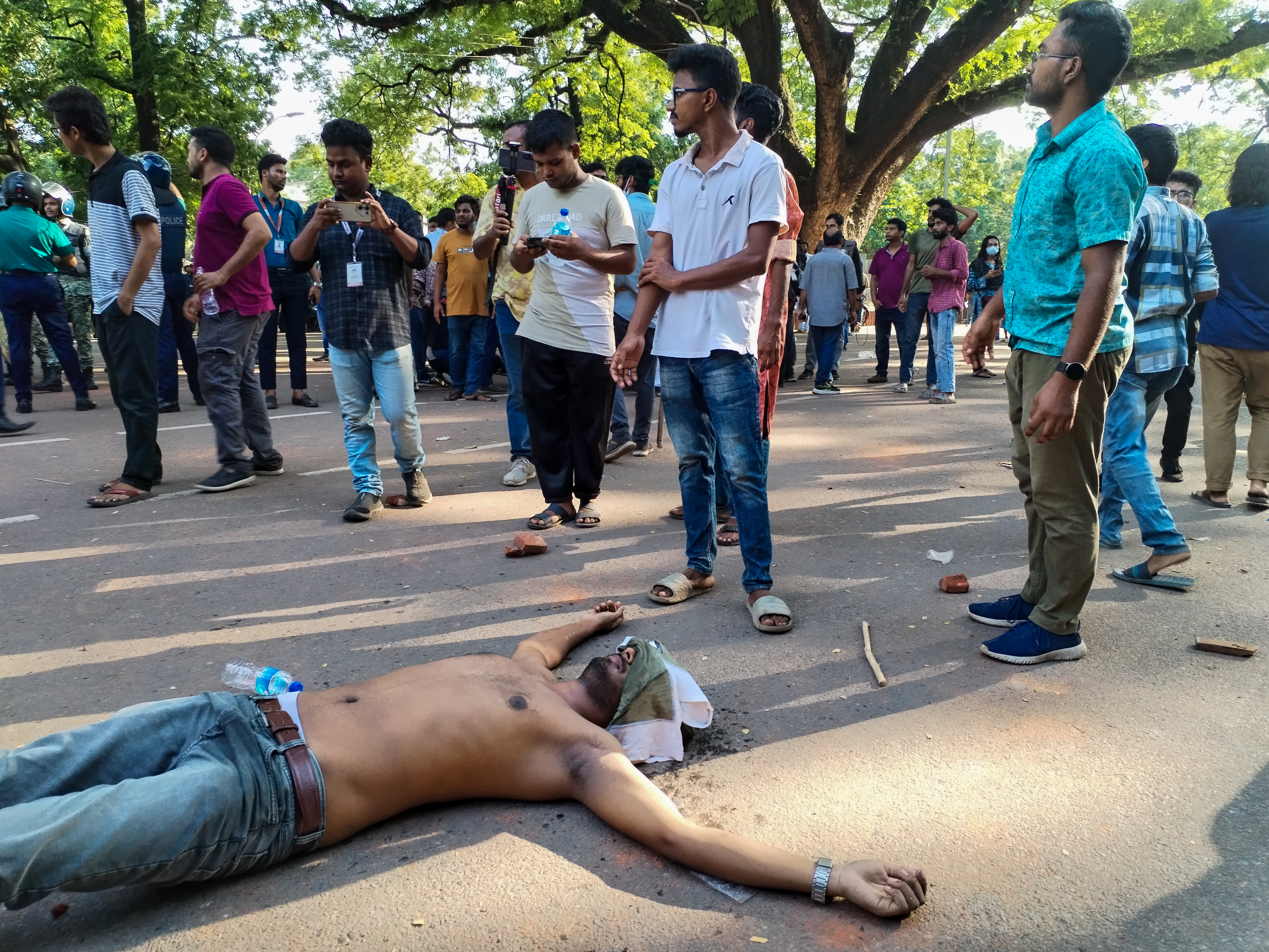
After being hit by a tear gas shell, a student lay down on the street, Dhaka, Bangladesh, July 17, 2024. Photo by Saqlain Rizve.
In this digital age young people consume these news stories regularly and often comment on them on social media. The continuous exposure of corruption, an economic recession, and growing unemployment all contributed to the youth outrage over a questionable system where 56 percent of jobs are reserved under various quotas.
Amid these turbulent times, the Awami League government has been intensifying its crackdown on opposition parties and dissenting voices for the past decade. Numerous leaders from the main opposition party, the Bangladesh Nationalist Party (BNP), have been arrested or faced legal challenges, limiting their ability to mobilize and campaign.
Continuing that trend, the Awami League blamed the BNP for the violence this week, and police raided the opposition party’s headquarters late on July 16. The Awami League’s general secretary blamed “evil forces” from the BNP for taking over the student protests.
The government’s suppression also extends to journalists and activists, with reports of increased censorship and harassment, creating a climate of fear that stifles free speech and democratic engagement. This heavy-handed approach has drawn criticism from international human rights organizations and added to the growing discontent within the country.
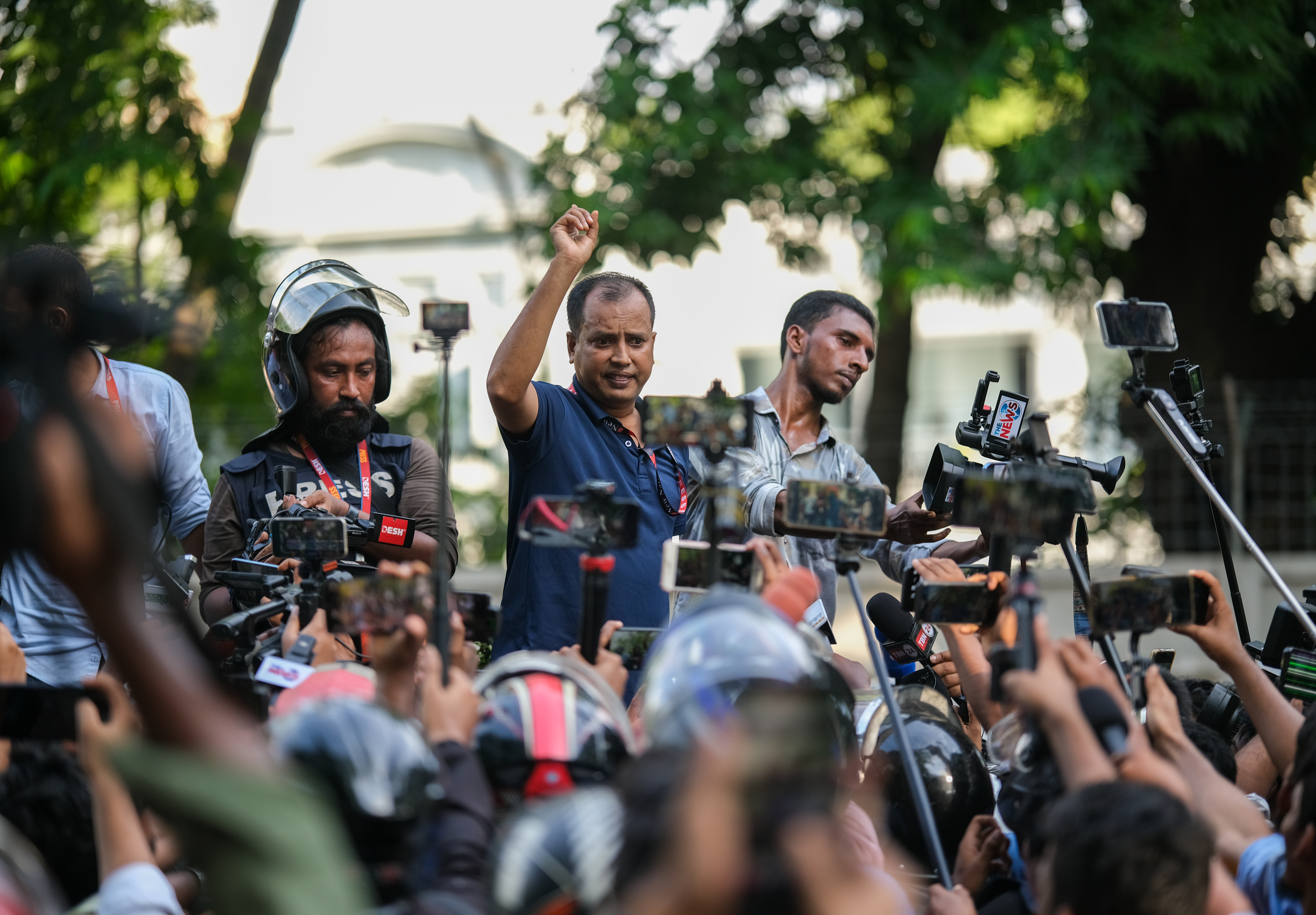
The police threw sound grenades and tear gas shells toward journalists, resulting in one injury. In response, the journalists became angry and demanded an apology from the police. Photo by Saqlain Rizve.
Internationally, Bangladesh faces pressure from multiple fronts. Western nations, particularly the United States, have expressed concerns over human rights abuses and the lack of democratic processes in recent elections. This has led to discussions about potential sanctions, which could further isolate the country economically and diplomatically.
Relations with neighboring countries have also been strained. Tensions with India have risen over water-sharing disputes and border management issues.
Hasina’s recent visit to China did not yield the anticipated financial support. The government hoped to secure a $5 billion loan to bolster the economy; instead, China consented to provide financial assistance of 1 billion yuan, which amounts to approximately $137 million. This sum falls short of the expectations set prior to the visit, where Bangladesh sought substantial economic aid.
Meanwhile, the unresolved Rohingya crisis continues to be a significant diplomatic and humanitarian challenge. Since 2017, Bangladesh has sheltered over 1 million Rohingya refugees who fled persecution in Myanmar. The burden of providing for such a large refugee population has strained Bangladesh’s resources and patience, with little progress made toward repatriation or international support to resolve the crisis.
Making matters worse, the conflict inside Myanmar between the junta military and rebel groups often destabilize the border areas. Hundreds of Myanmar’s border guard police and junta military troops have crossed the border into Bangladesh, seeking refuge.
The combination of these domestic and international challenges means Hasina’s current term is off to a grim start. As inflation rises and economic conditions worsen, public dissatisfaction grows. The aggressive suppression of opposition and dissent has only served to unite various discontented groups against the government. The coming months will be crucial for the Awami League as they navigate these multifaceted challenges and attempt to stabilize the situation both politically and economically.
Notably, student protests in Bangladesh have wielded significant influence historically, from the Language Movement of 1952 to the pro-democracy movements of later decades and the country’s independence in 1971. These protests have galvanized public opinion, pressured governments, and catalyzed reforms. If the current student-led movement against the quota system and government policies continues this tradition of activism, there may be a wind of change in the not-to distant future.













